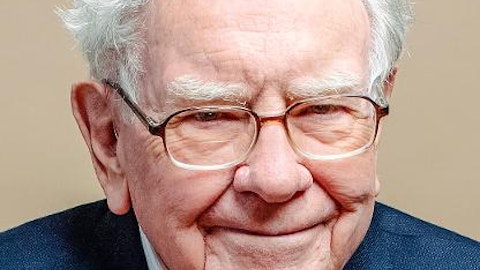Morgan Stanley (NYSE:MS) Q4 2022 Earnings Call Transcript January 17, 2023
Operator: Good morning. On behalf of Morgan Stanley, I will begin the call with the following disclaimer. This call is being recorded. During today’s presentation, we will refer to our earnings release and financial supplement, copies of which are available at morganstanley.com. Today’s presentation may include forward-looking statements that are subject to risks and uncertainties that may cause actual results to differ materially. Please refer to our notices regarding forward-looking statements and non-GAAP measures that appear in the earnings release and strategic update. Within the strategic update, certain reported information has been adjusted as noted. These adjustments were made to provide a transparent and comparative view of our operating performance against our strategic objectives.
The reconciliations of these non-GAAP adjusted operating performance metrics are included in the notes to the presentation or the earnings release. This presentation may not be duplicated or reproduced without our consent. I will now turn the call over to Chairman and Chief Executive Officer, James Gorman.

James Gorman: Thank you, operator. Good morning, everyone. Thanks for joining us. The macro backdrop of the last year presented challenges we haven’t seen for some time. The combined impact of persistent inflation and rapid central bank tightening pressured asset levels and led to very little strategic activity and capital raising. Despite volatility throughout the year, Morgan Stanley demonstrated resilience and delivered on an ROTCE of 16%, including integration-related expenses from our deals. The firm did what it was supposed to do with our more stable Wealth and Investment Management businesses offsetting declines in Institutional Securities. This is hard evidence of the transformation we’ve made to become increasingly durable and a stark contrast to the 8% ROTCE we had in the last notable challenging environment of 2015.
When markets rebound, we will capitalize on growth once again across the full firm and from an even stronger position. Before turning to Sharon to discuss the details of the fourth quarter and the full year, I’ll walk you through now how we plan to achieve these goals in our annual strategic update appropriately titled delivering growth through the next decade. Briefly first, I’d like to acknowledge the many contributions Jon Pruzan made as CFO and COO. As you know, he’s retiring from Morgan Stanley at the end of this month, and we wish him the absolute best. Please now turn to the deck into Slide 3. What informs our confidence in growth strategy is that we know who we are. We’ve been clear about that for over a decade. Our clarity of purpose has been a key driver of our success to date, and the next decade will be no different.
On Slide 4, you can see we’ve been consistent since the financial crisis. We have a client-centric franchise with a common objective to facilitate capital flows between those who have it and those who need it. We’re committed to our clients and to the markets we’re in, clearly illustrated by the leading competitive positions we have. In each of our businesses, we have a significant competitive moat, which will enable us to maintain and further enhance our strength. Slide 5 highlights the strategic decisions we’ve made over the past decade that are focused on aligning markets — ourselves to the markets where we perform best. And these are core businesses with scale in major markets that are on the whole more balance sheet-light and benefit from more durable fee-based revenues.
We continue to invest in these areas to drive future growth. We have proven track record in our ability to acquire and integrate the businesses that are aligned with this strategy, namely within Wealth and Investment Management. Importantly, we’ve also taken action to get out of businesses that are not core to this flow of capital. While we may facilitate activities across varied markets, we do not own businesses that are built around unsecured consumer credit payments, physical handling of commodities and the like. Instead, we focus on markets we best, and our ability is there to support our clients in those markets. Please turn to Slide 6. This illustrates the ongoing growth and shift of our business mix. As we continue to grow our client assets, we expect Wealth and Investment Management will become an increasingly larger portion of the firm’s pretax profit.
The stability of the firm will be further enhanced by this growth, all the while coupled with a preeminent institutional franchise. Fair to say our business model was tested this year, as you can see on Slide 7. 2022 was a paradigm shift. But first the common acts continuation of the first pandemic in 100 years, the first war in Europe over 70 years and the highest inflation in 40 years. Despite lower asset values and an anemic underwriting calendar, the firm performed well. We generated, as I said before, a 16% ROTCE and the most excess risk-based capital of our peers and attracted over $300 billion of net new assets, all while integrating two major acquisitions. So, now moving to the opportunities to maximize growth in the next decade, let’s start with Wealth Management.
On Slide 8, you can see we have leadership positions across channels, reflecting our combination of best-in-class advice and best-in-class technology. And we have the ability to meet any client wherever they are in their wealth accumulation journey. This allows us to grow with our clients along the way and provides the opportunity for clients to migrate across channels. The growth of our business is reflected in our higher average daily revenues, something I’ve been tracking for well over a decade. 2022, every trading day saw revenues in excess of $80 million, and over 1/3 of those exceeded $100 million a day. Contrast that with only three years ago, where 95% of trading revenues were each below $80 million, and none exceeded $100 million. It is through the journey as illustrated on Slide 7, Wealth Management has gone through a powerful transformation, as you all know, including with the most significant recent acquisitions in E*TRADE and Solium, which have expanded our client base with two new channels.
Today, we have 18 million relationships. We focus on deepening those relationships far up the right product at the right time and consolidating assets under our platform. From here, we’re building on the scale and the tools to reach — and the reach that will propel future growth. Net interest income has certainly been part of the profitability expansion to date, and you can see the driving forces highlighted on Slide 10. We have invested in expanding our bank offerings, allowing us to offer attractive products to our clients on both sides of their balance sheet to meet their needs. We’ve nearly doubled our lending balances over the last three years, and we expect to continue to grow attractive high-quality loans. On the other side, our deposit franchise has grown significantly since 2019 and will continue to support future NII through various cycles.
Approximately 90% of our deposits are sourced from our Wealth Management client base. And in the current rising rate environment, our cost of deposits is more efficient than that we experienced in the last rate hiking cycle. Sharon will discuss this important topic and our outlook around NII further in a few minutes. Let’s turn to Slide 11. This now talks about NNA growth, net new assets. Over the last three years, our platform generated nearly $1 trillion of net new assets showing a clear step change from prior periods and marking Morgan Stanley as a leader across our peer group as an asset accumulator. Given the scale and reach of our businesses, we expect to deliver this pace of asset accumulation going forward. Obviously, there will be up and down individual years.
But over a three-year period, we expect to drive approximately $1 trillion in net new assets. Most importantly, as you can see on the right-hand side of this page, no single source is accounting for greater than 25% of this net new money. Some people think it’s just a result of recruiting. It is absolutely not. It’s a combination of several things, which the team has described as filling the funnel of net new money. You can see on Slide 12, which shows our growth in client assets, we have experienced that through our workplace channel. We estimate now that relationships wealth held away has expanded by about 4x in the last three years. Our ability to serve clients across the entire wealth spectrum, we’re well positioned to consolidate a portion of these assets.
Further, the workplace channel continues to bring new relationships to the platform. We’ve executed on key steps to deepen those. We’ve already reached our goal to roll out companion accounts to 90% of workplace participants and to achieve 30% retention of stock plan assets. We look forward to even higher retention. The results of our client-driven strategy are illustrated on Slide 13. The workplace channel has driven the majority of our growth in client relationships and stands at 12 million relationships to date. While it can take several years to deepen those, we’ve already seen success in some parts of the offering that of our stock plan administrative services. Over the last three years, we’ve had approximately $350 billion of after-tax vested inflows.
Vesting assets gives us more opportunity to deliver an integrated client experience, and that’s allowed us to showcase the power of advice. To date, we’ve already seen advisor-led flows of approximately $150 billion that originated from a workplace relationship. Portion of those assets are the stock plan investor balances, but a larger portion are from assets that were previously held away. In short, we will — as we deliver our full suite of capabilities, our strategy to attract clients to advice is working. Investment Management has also delivered strong fee-based growth over the course of its own transformation, as you can see on Slide 14, which encapsulates the business together with Eaton Vance. This business has more than doubled its durable asset management and related fees since 2014.
And importantly, this significantly larger revenue base is more diversified. Increased diversification from fixed income, customization and alternatives continues to support results in more volatile equity markets. We remain very aligned to key growth areas. Our alternative investment capital is at $210 billion with strong growth in private credit, real assets, including infrastructure, our multi-strategy hedge fund platform and special situations. And customization by our market-leading parametric business continues to be a significant growth engine. Shifting to Institutional Securities on Slide 15, we have a global and balanced franchise. And our integrated investment bank has and continues to focus on meeting clients where they are active.
This has served us well as our strength is evident across various market environments. We remain a leader in equity in Investment Banking and have steadily rebuilt our fixed income franchise focused on our strongest capabilities. On Slide 16, you can see our institutional business remains a top three global leader in the industry, as demonstrated by a wallet share position. We have demonstrated our ability to defend share and gain it in relatively more capital-light businesses. At the same time, we’ve shown prudent several resources as illustrated clearly by the disciplined RWA usage, which actually dropped from ’21 to ’22 and our consistent G-SIB surcharge of 3%. Let’s move to our capital strategy on Slide 17. We have 200 basis points of excess capital above our regulatory requirement.
This is intentional. Our capital strategy has focused on bringing the risk down in our businesses, and we’ve seen a steady decline in our SCB excluding the dividend add-on reflective of our more durable business mix. Our capital position gives us enormous flexibility, and we’re comfortable with our decision to be prudently positioned. On Slide 18, you can see our excess capital position enables us to continue to invest in our business for future growth and deliver robust returns to shareholders. Our business transformation, especially the durable earnings from Wealth and Investment Management, enable us to double that dividend — enabled us to double our dividend in 2021 and further increase it by 11% in 2022. At the same time, we’ve reduced our shares outstanding from the much higher levels driven by the impact of our recent acquisitions.
Taken together, we delivered a 9% capital return to our shareholders last year. We remain committed to ongoing shareholder return, adjusting always for whatever the business performance is and the regulatory requirements demand. Shifting to how we see the future state on Slide 19. Starting with the expected path to $10 trillion in client assets across Wealth and Investment Management, we’ve demonstrated our ability to generate over the last three years positive net new assets of approximately $300 million a year. Combining that with reasonable average market assumptions give us the confidence this will lead to $10 trillion in client assets in reasonable years ahead. Now let’s consider this within the broader firm picture, and bear with me for a minute.
In 2022, the firm delivered $14 billion of pretax profit. In this future scenario of $10 trillion of assets, which I believe will happen, generating approximately 50 basis points of revenue which is about what we’re doing currently at a 30% pretax margin, which is within 2% of what we’re doing currently. If you put that math together, it should create of itself over $14 billion of pretax income. As you can see, that exceeds that of the full firm today just from the wealth and asset management businesses. So if you pull it all together, just to wrap it up, Slide 20 reiterates our confidence in our performance goals. They have not changed on account of what’s going on in the markets in the last 12 months. These are the metrics we need to support our longer-term objectives.
Of note, we’ve added a new goal that I spoke to earlier that we’ve talked about in the last six months to generate $1 trillion in net new assets approximately every three years. Again, I’m sure there will be volatility quarter by quarter, year by year. But as we’ve demonstrated through the funnel of sources, we expect an outcome over three years of approximately $1 trillion. That’s about by the way up to 5% to 7% of beginning period assets within wealth and asset management. As we approach 2023, we do so with quiet confidence, recognizing we have a line of sight with the durability of our Wealth and Investment Management businesses and our market share leading positions across much of Institutional Securities. As always, our objectives are subject to major moves in the economic, political or regulatory environment.
However, with a constructive outlook and a proven track record we’ve delivered thus far, we fully expect to achieve our goals over time. I will now turn the call over to Sharon, who will discuss the fourth quarter and annual results and we’d be delighted to take your questions.
See also 10 Best Performing Actively Managed ETFs in 2022 and 10 Best Cryptocurrencies to Invest In.
Sharon Yeshaya: Thank you, and good morning. In a complex year, the firm delivered solid results. Full year revenues were $53.7 billion, and PBT was $14.1 billion. The fourth quarter contributed to $12.7 billion in revenues and PBT of $2.8 billion. The strategic investments we have made over the last decade have paid off. Wealth Management had a record year and Fixed Income had its strongest performance in over a decade. While the firm was broadly impacted by increased volatility and economic uncertainty, the business model performed very well in a challenging environment as it was designed to do. The full year results included $470 million of integration-related expenses of which $120 million were incurred in the fourth quarter.
Excluding these impacts, EPS was $6.36 and $1.31 for the full year and for the quarter respectively. The full year ROTCE was 15.3% and 15.7% excluding the costs associated with integration. In the quarter, severance expenses of $133 million related to a December employee action and a net discrete tax benefit — or net discrete tax benefits of $89 million largely offset each other through net income. The full year efficiency ratio was 73.2%. Excluding integration-related expenses, our full year efficiency ratio was 72.4%. Total expenses were approximately flat to the prior year. Lower compensation expenses principally related to movements in DCP and on lower revenues were offset by higher non-compensation expenses primarily driven by investments in technology as well as increased marketing and business development spend.
As a reminder, this year also included a $200 million charge related to a legal matter regarding the firm’s record-keeping requirement in the second quarter. As the environment evolved over the course of 2022, we actively managed our expense base. Cognizant of the ongoing macro uncertainty, we continue to review efficiency opportunities. We are in the final stages of completing our integration of both E*TRADE and Eaton Vance. And this will be the last quarter we present measures that exclude integration-related expenses from reported results. However, particularly as it relates to the integration of E*TRADE, the final back-office integration remains scheduled to conclude in 2023. We expect to incur approximately $325 million of additional integration-related expenses this year.
These expenses will largely be spread evenly across quarters with approximately 2/3 related to E*TRADE and 1/3 related to Eaton Vance. Now to the businesses. Institutional Securities full year revenues of $24.4 billion declined 18% from the record prior year. In the fourth quarter, revenues were $4.8 billion. Overall, quarterly client engagement across fixed income and equities tapered from the higher levels seen in the first nine months of the year, reflective of seasonality and the macroeconomic environment. Weaker Investment Banking results persisted, reflecting the challenging banking backdrop. Investment banking revenues were $5.2 billion for the full year, down 49% from the record prior year. Advisory delivered its second best result, supported in part by the completion of previously announced strategic transactions.
Underwriting was more challenged, in line with the broader market. Full year global equity volumes dropped to levels unseen in the last 20 years. Debt volumes contracted following the first quarter. And while the market was receptive to higher quality issuance, activity was limited to constructive market periods. Fourth quarter revenues of $1.3 billion decreased 49% from the prior year. Lower completed M&A and underwriting market volumes weighed on results. As we have highlighted in prior quarters, client dialogue and engagement remains high as clients seek advice to navigate the difficult environment. Greater economic clarity should lead to increased confidence to undertake strategic transactions. And looking ahead, we expect issuers to take advantage of these windows of opportunity.
Equity full year trading — excuse me, equity full year revenues were $10.8 billion, representing another strong year of over $10 billion and making us a global leader in this business. Revenues declined 6% from the record prior year primarily driven by lower market activities. Revenues were $2.2 billion in the quarter, reflecting lower asset levels and volumes. Prime brokerage revenues were lower than the prior year as average client balances declined from record levels driven by lower equity markets and deleveraging. Cash results declined on lower client activity across regions. Derivative results increased slightly as the business navigated the market volatility well. Last year’s fourth quarter also benefited from a mark-to-market gain on an investment versus a markdown this quarter.
Fixed income revenues of $9 billion for the full year were the highest in over a decade. The divergence between the Fed’s guidance on financial tightening and conditions and the market expectations engaged clients and drove revenues in macro while volatile energy markets benefited commodities. Quarterly revenues were $1.4 billion. Macro performance benefited from higher client engagement as inflation expectations moderated, and clients repositioned in rates and foreign exchange. Strength in micro was supported by active secondary markets as expectations for inflation tempered and credit spreads tightened, driving an increase in client activity. Results in commodities were down significantly and primarily reflected lower revenues in the power and gas businesses.
Other revenues included $356 million of mark-to-market losses on corporate loans held for sale and loan hedges. These losses were substantially offset by net interest income and fees of $287 million. Turning to Wealth Management. For the full year, Wealth Management produced record revenues of $24.4 billion and a record pretax profit of $6.6 billion, resulting in a PBT margin of 27%. Excluding integration-related expenses of $357 million, the PBT margin was 28.4%. Full year results reflect mark-to-market impacts of our deferred cash-based compensation plans referred to as DCP. This negatively impacts our full year revenues by $858 million with a corresponding decrease of $530 million in compensation expenses. As we have explained historically, there is typically a timing difference between the mark-to-market gains and losses on the economic hedges and the deferred recognition of the compensation expense over the vesting period.
The revenue and the expense impact of DCP is now included in our financial supplement. Fourth quarter revenues were a record of $6.6 billion and the PBT margin was 27.8%. Including integration-related expenses of $94 million, the PBT margin was 29.2%. Total client assets were $4.2 trillion. Fee-based flows were $20 billion in the quarter, and asset management revenues were $3.3 billion. Net new assets of $311 billion in the year represent a 6.2% annual growth rate of beginning period assets. Fourth quarter net new assets were $52 billion with contributions across channels. Transactional revenues in the fourth quarter were $931 million. Including the impact of DCP, transactional revenues declined 15% from the prior year. The decline was driven by lower levels of overall retail engagement and fewer new issuance opportunities, partially offset by increased transactions related to fixed income products.
Bank lending balances grew by 17% in the year or 13% — or $17 billion in the year or 13% and stand at $146 billion. The pace of lending growth slowed for the second consecutive quarter and was largely unchanged sequentially. While mortgages and tailored loans continue to grow slowly, this was offset by pay downs in securities-based lending due to the higher interest rate environment. Total deposits rose 6% sequentially to $351 billion driven by continued demand for our savings offering among our Wealth Management clients. We have seen success with our strategy to provide advisers with expanded tools needed to offer their clients choice in varied market environment. Further, the pace of sweep outflows also moderated in the quarter. As a result, we have a favorable deposit mix, largely sourced from our Wealth Management client base with attractive pricing and options to meet our clients’ needs.
Net interest income was $2.1 billion in the quarter. The 52% increase from the prior year was driven by the benefits of the increased rate environment, an efficient deposit mix and strong lending growth over the last 12 months. Looking ahead, we do not believe that NII is peaked. We entered the year with an attractive deposit base with higher intrinsic value. While we expect the growth of NII to moderate from the pace of the last two quarters, we anticipate continued expansion in the first quarter of approximately 5% sequentially, assuming the forward curve is realized. Investment Management reported full year revenues of $5.4 billion, declining 14% from the prior year. The challenging market backdrop led to lower accrued carried interest in several of our private funds.
Also — and also impacted our AUM, which declined to $1.3 trillion. Fourth quarter revenues were $1.5 billion. Long-term net outflows of $6 billion in the quarter were driven by equities and fixed income, reflecting the challenging public market backdrop, partially offset by demand for alternatives and solutions, particularly parametric customized portfolios as well as our special situation strategies and private credit. Fourth quarter asset management and related fees were $1.4 billion, declining on the back of lower average AUM, partially offset by higher liquidity revenues. As a reminder, performance fees are recognized on an annual basis, largely in the fourth quarter, which drove the increase versus the third quarter. Quarterly performance-based income and other revenues were $90 million.
We saw broad-based gains in our private alternatives portfolio, though lower than the prior year. The diversification we gain from having fixed income, parametric customization and alternatives positions us well to perform through the cycle. We continue to invest in this business and leverage our premier global distribution capabilities to support future growth to meet continued global client demand. Turning to the balance sheet. Total spot assets were $1.2 trillion. Standardized RWAs declined by $9 billion sequentially to $449 billion, reflective of our prudent management of resources. Our standardized CET1 ratio was 15.3%, up 50 basis points from the prior quarter. Solid earnings, lower RWAs and gains in OCIs partially offset by capital actions contributed to our strong CET1 ratio.
We continue to execute our buyback program, and we repurchased approximately $1.7 billion of common stock in the quarter. The full year tax rate was 20.7% driven by the resolution of certain historic tax matters and the realization of certain tax benefits. We expect our 2023 tax rate to be approximately 23%, which will exhibit some quarterly volatility. The firm’s results demonstrate the ability of our business model to perform in an evolving environment. While there are, of course, uncertainties as we look ahead into 2023, we remain the growth opportunities in the year ahead. Our combined $5.5 trillion of assets across Wealth and Investment Management provides us balance. Importantly, our scale positions us well to capture the asset opportunity when the markets recover.
Finally, while still very early in the year, we are encouraged by the levels of client engagement we’ve seen so far. With that, we will now open the line to questions.
Operator: We’ll go first to Glenn Schorr with Evercore ISI.
Glenn Schorr: I appreciate all the slides, too. Okay. Two big picture questions, I guess. One, James, with the 200 basis points of excess CET1 requirements, the big buffer served you well. You’ve got a lot of buybacks, but also it’s dilutive to returns. And I’m just curious how you balance that of keeping that buffer or is that buffer more temporary weighting on Basel III end game final results? Or is that something you want — you plan on sitting at? I’m just curious on your big picture resting spot for that excess capital.
Q&A Session
Follow Morgan Stanley (NYSE:MS)
Follow Morgan Stanley (NYSE:MS)
James Gorman: Sure. Glenn, it’s a great question, and it’s sort of pivotal to the whole strategic positioning of the firm because right now, I think capital strategy is critical. There are a few things going on. Firstly, we have been able to reduce our peak to trough in CCAR because of the change in mix in our business. Secondly, because of the market environment we’ve reduced RWAs, just we’ve taken maybe a more prudent lean in. And obviously, we can reverse that at any point in time, which heats up CET1. Thirdly, we have the Basel III finally looks like it’s coming to fruition at some point in the first half of the year, although I don’t expect that banks will be required to implement whatever the new capital rules are until the beginning of 2025.
So while there’s a pretty long time frame, a year is a long time in this business, let alone 1.5 years, I still think that it’s prudent to kind of have some capital sitting there and just — I’d rather be in a position where we have excess capital when particularly in an environment where we don’t see obvious places we’ve put it to work. Now that said, we did our best. We bought back I think it was $8 billion and $10 billion last year. We doubled the dividend the year before. We increased the dividend 11% last year. Obviously, we’re — I mean, it’s fair to assume that we’re going to continue moving on capital distributions. But I like a number of 15%. We actually — we triggered a little higher than that this quarter. We could easily drop down to 14.5%.
That wouldn’t bother me at all, but that will be driven by the environment and business opportunities. So, great position to be in coming into a change in the regulatory outlook potentially, and we can always act aggressively, and we’ve proven we will do that when we have more clarity.
Glenn Schorr: I appreciate that. One other big picture is so Wealth Management is growing great. Everybody is happy. I think historically and even now, you’ve been considered very equity-centric from whether it be wealth and asset management or your dominant equities platform. So curious if you’re thinking about it’s possible with these higher rates, lots of clients shift to a more defensive stance. There’s good income out there to be earned without much risk or too much risk. If we see a more material shift towards fixed income appetite in general, do you think that in any way disadvantages Morgan Stanley as a firm and overall profitability?
James Gorman: I mean, listen, our share of fixed income is 10%; banking, 15; equities, 20. So obviously, the fixed income call grows. By the way, I share a few years ago, it was 6%. So the team under its head in Sam Kellie-Smith has done a phenomenal job. But if the pool grows faster in fixed income, just arithmetically, you’re not going to do as well as if the pool grew faster in equities. That doesn’t bother me a whole lot. I mean, we’ve never tried to be the FX EM shop. We’ve never had the global rates trading, FX trading macro businesses that some of the correspondent-driven commercial banks have had, the HSBCs and Citis. And that’s a business model just different. We don’t have as big transaction services, so we’re not going to have as much FX.
That said, what the team have done in macro under Jakob and the credit in Jay Hallik in commodities is really impressive. So I’m totally fine with that. And we clearly have the product. It’s not like we don’t sell muni bonds to our clients, and we don’t have fixed income underwriting, et cetera. We have the product. It’s just arithmetically, given our share relative to the others, we wouldn’t grow as fast. By the way, I was happy to see I think equities was back at number one this quarter, core franchise. And we’re really well positioned, Glenn. I’m not bothered by that at all.
Operator: We’ll take our next question from Ebrahim Poonawala with Bank of America.
Ebrahim Poonawala: I guess maybe first question, just Sharon, following up on the efficiency ratio about 72% for 2022. As we think about the journey from 72% to something sub-70% kind of in line with your strategic target, a sense of what it means. Is it this time? And are the businesses growing, which are more efficient and that changes the mix? Or could we see that up 70% even over the next couple of years? Would love to hear it in terms of both from a timing standpoint and what needs to happen at the firm to get to a sustainably below 70% efficiency ratio.
Sharon Yeshaya: Sure. So if you think about, we were — we’ve been below 70%, right? So if you look back to the last couple of years, and there are periods of time where we are below, there’s obviously two pieces to it, both the expense side and the revenue side. I think that as we continue to gain scale across the businesses, each of those dollars that we put to work will be more and more efficient. As I highlighted, where we’ve been investing a lot of those dollars is on the technology side. I noted that in my prepared remarks, and we have seen that both from the cyber resiliency side and also just as we think about the broader integrations of all of the platforms that we’ve acquired over the last couple of years. So as I think through it and I think about the timing, obviously, a different revenue environment will certainly help.
And there’s tremendous operating leverage, particularly as you think about the Institutional Securities business, which will help to drive that. Now if you go through each of the businesses, each of those businesses also exhibit operating leverage, right? If you have a constructive market environment, we’ve seen very strong margins also from the Investment Management business. We’re on our way to achieve the 30% margin target as you relate to the Wealth Management business. So I’d say it’s a balance of both, both the revenue environment and how that turns around and then just continued discipline in making sure that we have the right investments as we think about our expense base going forward. So we’ve been extremely prudent and disciplined as we think about the base over the last especially nine months that we’ve seen with this type of environment.





